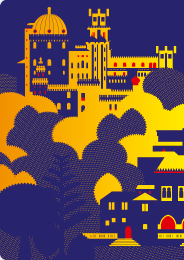New Passport
The development of a Secure Document requires meticulous care and attention, technical knowledge and close coordination between experts.

Historic Centre of Guimarães
The Historic Centre of the city of Guimarães contains, in its eclectic buildings, an important part of the history of Portugal as a territory. From its terreiras – simple, single storey houses – to one and two-storey residences, from the noble houses to the imposing Ducal Palace, the city has preserved an ensemble of architectural heritage of unparalleled value dating from the thirteenth, fourteenth and fifteenth centuries. By the sixteenth century, new housing typologies had emerged within the cityscape, characterised by the formal and decorative singularity of their façades, the quality of the stonework and the ostentation displayed in coats of arms. In the seventeenth century, along with a growing diversity of built typologies, buildings that were uniform in volume and height emerged, while cornices were suppressed and roofs lain directly atop façades, creating the singular and characteristic effect of eaves advancing over the outline of the streets. More informationPrehistoric Rock Art Sites in the Côa Valley and Siega Verde
The prehistoric rock art sites of the Côa Valley and Siega Verde contain engravings dating mostly from the Upper Palaeolithic Age (more than 10,000 years ago). They also contain examples of paintings and engravings from the Neolithic and Chalcolithic eras, as well as engravings from the Iron Age and from the seventeenth to twentieth centuries, when millers – Côa's last engravers – left the valley bottom. These rock art sites comprise the most important ensemble of open air Palaeolithic art on the Iberian Peninsula. More information
Cultural Landscape of Sintra
In the nineteenth century, Sintra was the prime focus of European romantic architecture. Here, Fernando II transformed the ruins of a monastery into a castle where a new sensibility was expressed through the use of elements of Gothic, Egyptian, Islamic and Renaissance influence, and the creation of a park combining essences of the local and the exotic. Based on the same model, other prestigious residences were built on the mountain, making the locale a unique example of parks and gardens that influenced various landscapes across Europe. More information
Fado
Sung individually and accompanied by the viola and Portuguese guitar, Fado was born in the historic neighbourhoods of Lisbon – Mouraria, Alfama, Bairro Alto and Madragoa. Sung with intense passion and soul, it is indelibly linked to the inevitability of fate and love. Today, it has become a music of the world, a recognised symbol of Portugal and recently designated by UNESCO as an Intangible Cultural Heritage of Humanity. More informationThe convent of Christ, Tomar
The Convent of Christ, including the Castle of Tomar that once belonged to the Order of the Knights Templar, is a unique monumental complex combining some of the most important influences on Portuguese architecture from the twelfth to the eighteenth centuries. Noteworthy are its Romanesque rotunda (charola), inspired by the Holy Sepulchre Rotunda of Jerusalem, the Manueline window in the Choir and the main cloister, one of the finest works of the European Renaissance. More information
Laurissilva Forest, Madeira
The Laurissilva forest of Madeira constitutes the remnants of a primeval forest that has resisted five centuries of humanisation. According to accounts from the era of Madeira's discovery (1420), the entire island was once covered in dense forests, inspiring Portuguese explorers to name the island "Madeira" (meaning "wood"). With its subtropical, humid characteristics, the forest's origins extend back to the Tertiary age where it once occupied vast stretches of Southern Europe and the Mediterranean basin. The last period of glaciation led to its disappearance on the European continent and it now survives only on the Atlantic archipelagos of the Azores, Madeira and the Canary Islands. The Madeira Chaffinch (Fringilla coelebs maderensis) is one of the unique avifauna of the Laurissilva, where it is found in abundance. http://whc.unesco.org/en/list/934
Belém Tower, Lisbon
Strategically located on the river Tagus, the Tower of Belém was built between 1514 and 1519 as a defence system, serving as both a medieval tower and a modern bulwark. Apart from its military function, it stands as a prestigious landmark of King Manuel I’s reign (1469-1521), displaying the iconographic elements of the Manueline style. http://whc.unesco.org/en/list/263
University of Coimbra, Alta and Sofia
Situated on a hill overlooking the city, the University of Coimbra – Alta and Sofia has grown and evolved over more than seven centuries to form its own well-defined urban area of two components within the historic centre of Coimbra. Created initially as an academy in the late thirteenth century on the hill above the town (Alta), it was established in the Royal Palace of Alcáçova in 1537 before developing as a series of colleges. Coimbra University is an exceptional example of a university city that illustrates the interdependence between city and university, in which the city’s architectural language reflects the university’s institutional functions. More information
Manufacture of Cowbells
The cowbell is a percussion musical instrument of the idiophone family. Generally cup-shaped, made from iron and wrapped in copper or tin, it features a suspended internal clapper and a handle on the upper part through which a leather strap is passed to hang it around an animal’s neck. It comes in various shapes and sizes. While it can be used on all domesticated animals, it has been traditionally used by shepherds in pastures and to control livestock. In rural areas where it is used, it creates an unmistakeable soundscape. The techniques used by a master cowbell craftsman in making and tuning the instrument combine the metallurgical arts of coppersmithing, folding, blacksmithing and forging with a knowledge of music and tuning. The manufacture of cowbells is in danger of becoming extinct, due to the demise of traditional ways of pasturing and the loss of Portuguese genetic heritage: indigenous races whose numbers are now in the mere hundreds. An art that has remained virtually unchanged for more than 2,000 years, the Manufacture of Cowbells was inscribed by UNESCO on its List of Intangible Cultural Heritage in Need of Urgent Safeguarding in 2015. More informationAlto Douro Wine Region
The Alto Douro Wine Region is uniquely representative of a landscape that characterises the vast Demarcated Region of Douro, the oldest regulated wine-growing region in the world. The cultural landscape of Alto Douro combines the monumental nature of the Douro River valley, comprised of steep hillsides, poor soils and rugged terrain, with the ancestral, continuous actions of Man, adapting the space to the agricultural needs of the Mediterranean grape varieties sustained by the region. This intimate relationship between nature and human activity has allowed for the creation of a unique ecosystem in which the characteristics of the terrain are harnessed in an exceptional manner through the creation of terraced plots, which prevent erosion and enable the cultivation of wine. The region produces the world famous Port wine, representing the primary driver for revitalising technology, culture, traditions and the local economy. More information
The Garrison border town of Elvas and its fortifications
The Garrison border town of Elvas and its fortifications was classified as a World Heritage site by UNESCO in 2012. This designation includes the historic centre of the city of Elvas, the seventeenth century bulwarked city walls, the Fort of Santa Luzia, the Fort of Graça, the fortlets of São Domingos, São Pedro and São Mamede and the Amoreira Aqueduct. Containing the largest bulwarked dry ditch system in the world, Elva’s fortifications are unusually intact, well preserved and authentic in terms of their materials and construction techniques, and represent a key moment in history with respect to Architecture and Military History. More information
Historic Centre of Évora
Situated on the Alentejo plains at the confluence of three important river basins – Tagus, Sado and Guadiana – and serving as an age-old crossroads for transportation and trade in the peninsula, Évora has, since antiquity, assumed a political and social importance for every civilisation that has made a mark on modern day Portugal, enriched by 2,000 years of history as an urban centre. Remnants of the Roman presence include a road system and urban fabric that can still be verified in the city registry today, while the monumental Temple of Diana is a legacy of the ancient city. From the era of the Moorish occupation, which emerged in the shadow of the late Roman city walls, are the winding traces of a number of streets from the ancient portion of the historic quarter. More information
Cultural Landscape of the Pico Island Vineyards
The inscription of the Landscape of the Pico Island Vineyard Culture on the World Heritage list represents global recognition of this unique landscape, reflecting a singular expression of wine cultivation on a small volcanic island and its evolution since the arrival of the first settlers in the fifteenth century. This is a landscape that has persisted for centuries, its configuration influenced by the presence of viniculture. Its uniqueness is derived from a fundamental landscape element: a network of stone walls built to protect the vineyards from wind and seawater. The vineyards are the only culture that can subsist in this unproductive soil. More informationMonastery of Alcobaça
Inscribed on UNESCO’s World Heritage List, the Monastery of Alcobaça is the most important Cistercian abbey in Portugal. Founded in 1153, it was presented to Bernard of Clairvaux as a gift from King Afonso Henriques . Once one of the most powerful abbeys of the Cistercian Order, it has preserved almost all of its medieval monastic dependencies to this day, as well as the fourteenth century Gothic tombs of King Pedro and Inês de Castro. http://whc.unesco.org/en/list/505
Historic Centre of Porto
The city of Porto rises from the banks of the Douro River towards the neighbouring hills overlooking its estuary, forming an urban landscape built over a 2,000 year history in which a diversity of civil and religious architecture extending back to the Roman, Medieval, Renaissance, Baroque and Neoclassical eras testifies to the development of its Historic Centre. Built atop hilly terrain, where the organic layout of streets and houses blends in harmoniously with the river below, the Historic Centre has an unparalleled panoramic view, reinforced by a profusion of monuments including Porto Cathedral, the Church of Santa Clara and the Palácio da Bolsa. Designated as a World Heritage site in 1996, Porto's Historic Centre contains a wealth of monuments and views, capturing a diversity of urban design solutions from cities in Western Europe and the Atlantic-Mediterranean region from the medieval period to early modernity. More information
Monastery of Jerónimos
The Monastery of Jerónimos, whose founding is associated with the historical figures of King Manuel and Vasco da Gama, is inscribed on UNESCO’s World Heritage list. It is a masterpiece of Manueline architecture, featuring elements of Late Gothic and Renaissance styles. Its construction, initiated in 1501 on the banks of the river Tagus and completed over a century later, is closely linked to the Portuguese Discoveries and was made possible as a result of the revenues from trade with Africa and the Orient. More information
Historic Centre of Angra do Heroísmo, Azores
Blessed with geographical features and climatic conditions that allow for the safe harbouring of ships, the city of Angra do Heroísmo on Terceira Island in the Azores Archipelago emerged in the beginning of the sixteenth century and became an obligatory port of call for ships sailing to and from Mina, India and Brazil. Organised in an urban configuration dating from the Renaissance, the city grew in strategic importance and took on a monumental character, as seen in such works as the S. Sebastião and S. Filipe fortifications, the Cathedral of Santíssimo Salvador da Sé, the Church of Misericórdia and the Palace of the Captains-General. More information
Cante Alentejano
Cante Alentejano is a style of choral singing in which two solo voices (ponto and alto) in a choral group alternate with the other voices of the choir. Stanzas are repeated in a cycle, which goes on for as many rounds as the singers desire. This repetition, coupled with the slow tempo and multiple pauses, lends cante a particular uniformity that is exquisite. The themes of the songs, which are sung by groups of men or women, are typically mournful. In Cante Alentejano, songs speak often of melancholy, deep longing, love, desires and memories of the land of Alentejo. But Alentejo and cante can be joyful too, with songs of irony and humour. Whatever the case may be, vibrant voices have been enchanting listeners for centuries. As for the origins of cante alentejano, be it Gregorian chant or Arabic chant, they remain unconfirmed. More informationThe Mediterranean Diet
The Mediterranean Diet is a social practice based on a set of skills, knowledge, rituals and traditions, ranging from landscape to cuisine, that have developed within the Mediterranean basin, including farming, harvesting, fishing, conservation, processing, food preparation and, most notably, consumption. This set of practices is linked to an annual cyclical calendar marked by nature and its religious or ritual meanings. From a nutritional standpoint, the diet has been recognised for its excellence by the World Health Organization (WHO) and FAO. More information
Monastery of Batalha
A monument built in commemoration of a battle that ensured total independence from the kingdom of Portugal (1385), the Monastery of Batalha also served as a royal pantheon. This Dominican complex, whose construction began in the late fourteenth century, is the most important example of the European Late Gothic style in Portugal. It is also a unique testament to the cultural and artistic exchanges between the Southern Mediterranean and the North Atlantic, featuring a very important collection of medieval stained glass windows. http://whc.unesco.org/en/list/264How to get it
Find out how, where and what you need to acquire a passport

Passport

Special

Diplomatic

Temporary



